The transfer function starts with an infinite value with phase \$-90 {}^{\circ}\$. Therefore it has a pole at the origin.
When the frequency is infinity it's phase is \$-270 {}^{\circ}\$. This implies that it has two other poles.
Thus the general form of the transfer function is $$tf=\frac{k}{s (s+p1) (s+p2)}$$
Substitute \$s=i\ w\$ and split it into its real and imaginary parts.
{re, im} = ComplexExpand[ReIm[tf /. s -> I w]]
$$\left\{-\frac{k
\text{p1}}{\left(\text{p1}^2+w^2\right)
\left(\text{p2}^2+w^2\right)}-\frac{k
\text{p2}}{\left(\text{p1}^2+w^2\right)
\left(\text{p2}^2+w^2\right)},\\\frac{k
w}{\left(\text{p1}^2+w^2\right)
\left(\text{p2}^2+w^2\right)}-\frac{k \text{p1}
\text{p2}}{w \left(\text{p1}^2+w^2\right)
\left(\text{p2}^2+w^2\right)}\right\}$$
Now we have three conditions. The real part at zero frequency is -0.25, and the real and imaginary parts at some frequency \$w\$ are -0.5 and 0.
eqs = {(re /. w -> 0) == -0.25, re == -0.5, im == 0}
$$\left\{-\frac{k}{\text{p1}^2
\text{p2}}-\frac{k}{\text{p1}
\text{p2}^2}=-0.25,\\-\frac{k
\text{p1}}{\left(\text{p1}^2+w^2\right)
\left(\text{p2}^2+w^2\right)}-\frac{k
\text{p2}}{\left(\text{p1}^2+w^2\right)
\left(\text{p2}^2+w^2\right)}=-0.5,\\\frac{k
w}{\left(\text{p1}^2+w^2\right)
\left(\text{p2}^2+w^2\right)}-\frac{k \text{p1}
\text{p2}}{w \left(\text{p1}^2+w^2\right)
\left(\text{p2}^2+w^2\right)}=0\right\}$$
These are 3 equations in 4 unknowns \$\{k, p1, p2, w\}\$. We cannot determine an unique transfer function unless we know the frequency at which the plot crosses the \$\{-0.5, 0\}\$ point.
If it crosses at \$w=1\$, the transfer function will be
Chop@ExpandDenominator[tf /. NSolve[Join[eqs /. w -> 1, {k > 0}], {k, p1, p2}][[1]]]
$$\frac{0.353553}{s^3+0.707107 s^2+1. s}$$
If it's \$w=2\$, the solution will be
Chop@ExpandDenominator[tf /. NSolve[Join[eqs /. w -> 2, {k > 0}], {k, p1, p2}][[1]]]
$$\frac{2.82843}{s^3+1.41421 s^2+4. s}$$
So there are infinite possibilities.
